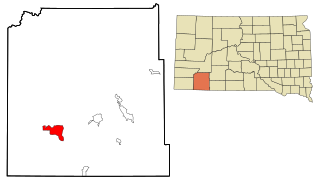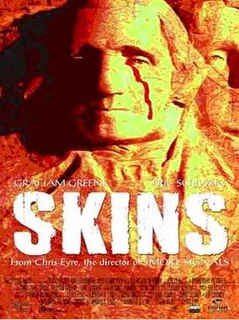Related Research Articles

The Lakota are a Native American people. Also known as the Teton Sioux, they are one of the three prominent subcultures of the Sioux people. Their current lands are in North and South Dakota. They speak Lakȟótiyapi—the Lakota language, the westernmost of three closely related languages that belong to the Siouan language family.

Oglala Lakota County is a county in southwestern South Dakota, United States. The population was 13,672 at the 2020 census. Oglala Lakota County does not have a functioning county seat; Hot Springs in neighboring Fall River County serves as its administrative center. The county was created as a part of the Dakota Territory in 1875, although it remains unorganized. Its largest community is Pine Ridge.

Wanblee is a census-designated place on the Pine Ridge Indian Reservation, located in Jackson County, South Dakota, United States. The population was 674 at the 2020 census, virtually all of whom are members of the Oglala band of Lakota Sioux. Wanbli is the Lakota word for eagle, and the town was named for its proximity to Wanbli hohpi paha. Wanblee is a few miles directly northeast of the North American continental pole of inaccessibility.

Kyle is a census-designated place (CDP) in Oglala Lakota County, South Dakota, United States. Its population was 943 at the 2020 census. Located within the Pine Ridge Indian Reservation of the Oglala Lakota, it is one of two settlements which are closest to the North American continental pole of inaccessibility.

Manderson-White Horse Creek is a census-designated place (CDP) in East Oglala Lakota Unorganized Territory in Oglala Lakota County, South Dakota, United States. The population was 554 at the 2020 census. Oglala Lakota tribesman, Kicking Bear died here on May 28, 1904. He fought in several battles during the Black Hills War, including Battle of the Greasy Grass. His nephew, Felix Flying Hawk owned a ranch.

Oglala is a census-designated place (CDP) in West Oglala Lakota Unorganized Territory equivalent, Oglala Lakota County, South Dakota, United States. The population was 1,282 at the 2020 census. Its location is northwest of the Pine Ridge Indian Reservation.

Porcupine is a census-designated place (CDP) in Oglala Lakota County, South Dakota, United States. The population was 925 at the 2020 census.

Wounded Knee is a census-designated place (CDP) on the Pine Ridge Indian Reservation in Oglala Lakota County, South Dakota, United States. The population was 364 at the 2020 census.

The Wounded Knee Massacre, also known as the Battle of Wounded Knee, was a massacre of nearly three hundred Lakota people by soldiers of the United States Army. It occurred on December 29, 1890, near Wounded Knee Creek on the Lakota Pine Ridge Indian Reservation in South Dakota, following a botched attempt to disarm the Lakota camp. The previous day, a detachment of the U.S. 7th Cavalry Regiment commanded by Major Samuel M. Whitside approached Spotted Elk's band of Miniconjou Lakota and 38 Hunkpapa Lakota near Porcupine Butte and escorted them five miles westward to Wounded Knee Creek, where they made camp. The remainder of the 7th Cavalry Regiment, led by Colonel James W. Forsyth, arrived and surrounded the encampment. The regiment was supported by a battery of four Hotchkiss mountain guns. They were responding to concerns of the settlers who were worried the Ghost Dance might be a prelude to an armed attack.

The Pine Ridge Indian Reservation, also called Pine Ridge Agency, is an Oglala Lakota Indian reservation located entirely within the U.S. state of South Dakota. Originally included within the territory of the Great Sioux Reservation, Pine Ridge was created by the Act of March 2, 1889, 25 Stat. 888. in the southwest corner of South Dakota on the Nebraska border. Today it consists of 3,468.85 sq mi (8,984 km2) of land area and is one of the largest reservations in the United States.

Wounded Knee Creek is a tributary of the White River, approximately 100 miles (160 km) long, in Oglala Lakota County, South Dakota in the United States. Its Lakota name is Čhaŋkpé Ópi Wakpála.

The Ghost Dance War was the military reaction of the United States government against the spread of the Ghost Dance movement on Lakota Sioux reservations in 1890 and 1891. Lakota Sioux reservations were occupied by the US Army, causing fear, confusion, and resistance among the Lakota. It resulted in the Wounded Knee Massacre wherein the 7th Cavalry killed over 250 Lakota, primarily unarmed women, children, and elders, at Wounded Knee on December 29, 1890. The end of the Ghost Dance War is usually dated January 15, 1891, when Lakota Ghost-Dancing leader Kicking Bear decided to meet with US officials. However, the US Government continued to use the threat of violence to suppress the Ghost Dance at Lakota reservations Pine Ridge, Rosebud, Cheyenne River, and Standing Rock.

The Rosebud Indian Reservation (RIR) is an Indian reservation in South Dakota, United States. It is the home of the federally recognized Sicangu Oyate – also known as Sicangu Lakota, and the Rosebud Sioux Tribe (RST), a branch of the Lakota people. The Lakota name Sicangu Oyate translates into English as "Burnt Thigh Nation"; the French term "Brulé Sioux" is also used.

The Cheyenne River Indian Reservation was created by the United States in 1889 by breaking up the Great Sioux Reservation, following the attrition of the Lakota in a series of wars in the 1870s. The reservation covers almost all of Dewey and Ziebach counties in South Dakota. In addition, many small parcels of off-reservation trust land are located in Stanley, Haakon, and Meade counties.

The Wounded Knee Occupation, also known as Second Wounded Knee, began on February 27, 1973, when approximately 200 Oglala Lakota and followers of the American Indian Movement (AIM) seized and occupied the town of Wounded Knee, South Dakota, United States, on the Pine Ridge Indian Reservation. The protest followed the failure of an effort of the Oglala Sioux Civil Rights Organization (OSCRO) to impeach tribal president Richard Wilson, whom they accused of corruption and abuse of opponents. Additionally, protesters criticized the United States government's failure to fulfill treaties with Native American people and demanded the reopening of treaty negotiations to hopefully arrive at fair and equitable treatment of Native Americans.

The Oglala are one of the seven subtribes of the Lakota people who, along with the Dakota, make up the Očhéthi Šakówiŋ. A majority of the Oglala live on the Pine Ridge Indian Reservation in South Dakota, the eighth-largest Native American reservation in the United States.

Skins is a 2002 American feature film by Chris Eyre and based upon the novel of the same name by Adrian C. Louis. The film is set on the fictional Beaver Creek Indian Reservation in South Dakota near the Nebraska border, a place very much like the actual Pine Ridge Indian Reservation, the setting in the book and the place where the film was actually shot. Lakota Sioux tribal police officer Rudy Yellow Lodge struggles to rescue his older, alcoholic brother, Mogie, a former football star who was wounded in combat three times in Vietnam. Winona LaDuke makes a cameo appearance as Rose Two Buffalo.

Spotted Elk, was a chief of the Miniconjou, Lakota Sioux. He was a son of Miniconjou chief Lone Horn and became a chief upon his father's death. He was a highly renowned chief with skills in war and negotiations. A United States Army soldier, at Fort Bennett, coined the nickname Big Foot – not to be confused with Oglala Big Foot.

Plenty Horses (1869–1933) was a Sicangu (Brulé) Lakota from the Rosebud Indian Reservation. On January 7, 1891, nine days after the Wounded Knee Massacre, he shot and killed Army Lieutenant Edward W. Casey, commandant of the Cheyenne Scouts two miles north of the Stronghold Table in the Badlands of the Pine Ridge Indian Reservation in South Dakota. Plenty Horses – who was present at the Drexel Mission Fight the day after the Wounded Knee Massacre, was arrested for the murder and his case went to trial. His defense was he shot and killed Casey as an effort to redeem himself in the eyes of his people after having spent five years at the Carlisle Indian School learning the ways of the white man. He returned in time to be present on the reservation during the massacre.
Five years I attended Carlisle and was educated in the ways of the white man. When I returned to my people, I was an outcast among them. I was no longer an Indian. I was not a white man. I was lonely. I shot the lieutenant so I might make a place for myself among my people. I am now one of them. I shall be hung, and the Indians will bury me as a warrior.

The Drexel Mission Fight was an armed confrontation between Lakota warriors and the United States Army that took place on the Pine Ridge Indian Reservation in South Dakota on December 30, 1890, the day after the Wounded Knee Massacre. The fight occurred on White Clay Creek approximately 15 miles (24 km) north of Pine Ridge where Lakota were purported to have burned the Catholic Mission.
References
- ↑ Federal Writers' Project (1940). South Dakota place-names, v.1-3. American guide series. University of South Dakota. p. 56.
- ↑ Wounded Knee & the Ghost Dance Tragedy by Jack Utter p. 25 Publisher: National Woodlands Publishing Company; 1st edition (April 1991) Language: English ISBN 0-9628075-1-6